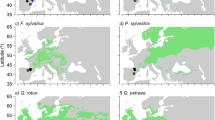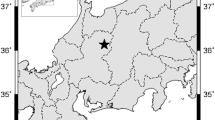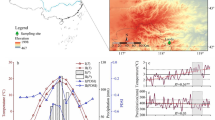Abstract
This study examined the effects of climatic conditions on tree-ring widths of red oak (Quercus rubra), sugar maple (Acer saccharum) and American beech (Fagus grandifolia) at their northern distribution limit in Mont St. Hilaire, eastern Canada. A residual chronology of tree-ring width index was developed for each species. The tree-ring width of Q. rubra showed negative and positive correlations with May temperature and June precipitation in the current year, respectively. A. saccharum also showed similar patterns with Q. rubra, i.e., negative and positive correlations with June temperature and precipitation in the current year, respectively. F. grandifolia showed neither positive nor negative correlations with temperature and precipitation. The expressed population signals of tree-ring width chronologies of the three species indicated that climatic factors more greatly influenced the variations in tree-ring widths in the order Q. rubra > A. saccharum > F. grandifolia. Therefore, the radial growth of Q. rubra was most restricted by drought stress in early summer among the three species. Global warming is suggested to affect the radial growth of the three species differently by increasing drought stress at Mont St. Hilaire in eastern Canada.



Similar content being viewed by others
References
Abrams MD (1990) Adaptations and responses to drought in Quercus species of North America. Tree Physiol 7:227–238
Arii K, Hamel BR, Lechowicz MJ (2005) Environmental correlates of canopy composition at Mont St. Hilaire, Quebec. Can. J Torrey Bot Soc 132:90–102
Bergeron Y, Brisson J (1990) Fire regime in red pine stands at the northern limit of the species range. Ecology 71:1352–1364
Berry PM, Dawson TP, Harrison PA, Pearson R, Butt N (2003) The sensitivity and vulnerability of terrestrial habitats and species in Britain and Ireland to climate change. J Nat Conserv 11:15–23
Biondi F, Waikul K (2004) DENDROCLIM2002: a C++ program for statistical calibration of climate signals in tree-ring chronologies. Comput Geosci 30:303–311
Cook BD (1971) Tree-age distribution in a northern hardwood forest. M Sci thesis, Department of Geography, McGill University
Cook ER (1985) A time series analysis approach to tree ring standardization. PhD thesis, University of Arizona, Tucson
Cook ER, Peters K (1981) The smoothing spline: a new approach to standardizing forest interior tree-ring width series for dendroclimatic studies. Tree-Ring Bull 41:45–53
Drobyshev I, Overgaard R, Saygin I, Niklasson M, Hickler T, Karlsson M, Sykes MT (2010) Masting behaviour and dendrochronology of European beech (Fagus sylvatica L.) in southern Sweden. For Ecol Manag 259:2160–2171
Drobyshev I, Guitard MA, Asselin H, Genries A, Bergeron Y (2014) Environmental controls of the northern distribution limit of yellow birch in eastern Canada. Can J For Res 44:720–731
Farrar JL (1995) Trees in Canada. Fitzhenry and Whiteside Limited and the Canadian Forest Service, Toronto
Fritts HC (1962) The relation of growth ring widths in American beech and white oak to variations in climate. Tree-Ring Bull 25:2–10
Fritts HC (1976) Tree rings and climate. Academic Press, London
Holmes RL (1983) Computer-assisted quality control in tree-ring dating and measurement. Tree-ring Bull 43:69–78
Holmes RL (1994) Dendrochronology program library version 1994. Laboratory of Tree-Ring Research, University of Arizona, Tucson
Hoshino Y, Yonenobu H, Yasue K, Nobori Y, Mitsutani T (2008) On the radial-growth variations of Japanese beech (Fagus crenata) on the northernmost part of Honshu Island, Japan. J Wood Sci 54:183–188
Iverson LR, Prasad AM (1998) Predicting abundance of 80 tree species following climate change in the eastern USA. Ecology 68:465–485
Jenkins MA, Pallardy SG (1995) The influence of drought on red oak group species growth and mortality in the Missouri Ozarks. Can J For Res 25:1119–1127
Kelly AE, Goulden ML (2008) Rapid shifts in plant distribution with recent climate change. Proc Nat Acad Sci USA 105:11823–11826
Kira T (1948) On the altitudinal arrangement of climatic zones in Japan. Kanti Nogaku 2:143–173 (in Japanese)
Lane CJ, Reed DD, Mrod GD, Leichty HO (1993) Width of sugar maple (Acer saccharum) tree rings as affected by climate. Can J For Res 23:2370–2375
LeBlanc D, Terrell M (2001) Dendroclimatic analyses using thornthwaite-mather-type evapotranspiration models: a bridge between dendroecology and forest simulation models. Tree-Ring Res 57:55–66
Maycock PF (1961) Botanical studies on Mont St. Hilaire, Rouville country, Quebec. General description of the area and a floristic survey. Can J Bot 39:1293–1325
Monserud RA (1986) Time-series analyses of tree-ring chronologies. For Sci 32:349–372
Morin X, Viner D, Chuine I (2008) Tree species range shifts at a continental scale: new predictive insights from a process-based model. J Ecol 96:784–794
Oberhuber W (2004) Influence of climate on radial growth of Picea cembra within the alpine timberline ecotone. Tree Physiol 24:291–301
Oladi R, Pourtahmasi K, Eckstein D, Bräuning A (2011) Seasonal dynamics of wood formation in Oriental beech (Fagus orientalis Lipsky) along an altitudinal gradient in the Hyrcanian forest. Iran. Trees 25:425–433
Pan C, Tajchman SJ, Kochenderfer JN (1997) Dendroclimatological analysis of major forest species of the central Appalachians. For Ecol Manag 98:77–87
Parmesan C, Yohe G (2003) A globally coherent fingerprint of climate change impacts across natural systems. Nature 421:37–42
Piovesan G, Adams JM (2001) Masting behaviour in beech: linking reproduction and climatic variation. Can J Bot 79:1039–1047
Robertson PA (1992) Factors affecting tree growth on three lowland sites in southern Illinois. Am Mid Nat 128:218–236
Rolland C, Petitcolas V, Michalet R (1998) Changes in radial tree growth for Picea abies, Larix decidua, Pinus cembra and Pinus uncinata near the alpine timberline since 1750. Trees 13:40–53
Rossi S, Deslauriers A, Anfodillo T, Morin H, Saracino A, Motta R, Borghetti M (2006) Conifers in cold environments synchronize maximum growth rate of tree-ring formation with day length. New Phytol 170:301–310
Rubino DL, McCarthy BC (2000) Dendroclimatological analysis of white oak (Quercus alba L., Fagaceae) from an old-growth forest of southeastern Ohio. USA. J Torrey Bot Soc 127:240–250
Sano Y, Matano T, Ujihara A (1977) Growth of Pinus pumila and climate fluctuation in Japan. Nature 266:159–161
Sykes MT, Prentice IC (1996) Climate change, tree species distributions and forest dynamics: a case study in the mixed conifer/northern hardwoods zone of northern Europe. Clim Chang 34:161–177
Takahashi K (2003) Effects of climatic conditions on shoot elongation of alpine dwarf pine (Pinus pumila) at its upper and lower altitudinal limits in central Japan. Arc Antarc Alp Res 35:1–7
Takahashi K, Hirai T (2016) Seasonal change in xylem growth of Pinus densiflora in central Japan. Landsc Ecol Eng. doi:10.1007/s11355-016-0292-8
Takahashi K, Homma K, Shiraiwa T, Vetrova VP, Hara T (2001) Climatic factors affecting the growth of Larix cajanderi in the Kamchatka Peninsula, Russia. Eur J For Res 3:1–9
Takahashi K, Azuma H, Yasue K (2003) Effects of climate on the radial growth of tree species in the upper and lower distribution limits of an altitudinal ecotone on Mount Norikura, central Japan. Ecol Res 18:549–558
Takahashi K, Tokumitsu Y, Yasue K (2005) Climatic factors affecting the tree-ring width of Betula ermanii at the timberline on Mount Norikura, central Japan. Ecol Res 20:445–451
Takahashi K, Arii K, Lechowicz MJ (2010) Codominance of Acer saccharum and Fagus grandifolia: the role of Fagus root sprouts along a slope gradient in an old-growth forest. J Plant Res 123:665–674
Takahashi K, Okuhara I, Tokumitsu Y, Yasue K (2011) Responses to climate by tree-ring widths and maximum latewood densities of two Abies species at upper and lower altitudinal distribution limits in central Japan. Trees 25:745–753
Tardif J, Brisson J, Bergeron Y (2001) Dendroclimatic analysis of Acer saccharum, Fagus grandifolia, and Tsuga canadensis from an old-growth forest, southwestern Quebec. Can J For Res 31:1491–1501
Tardif JC, Conciatori F, Nantel P, Gagnon D (2006) Radial growth and climate responses of white oak (Quercus alba) and northern red oak (Quercus rubra) at the northern distribution limit of white oak in Quebec, Canada. J Biogeogr 33:1657–1669
Thornthwaite CW (1948) An approach toward a rational classification of climate. Geograph Rev 38:55–94
Wigley TML, Briffa KR, Jones PD (1984) On the average value of correlated time series, with applications in dendrochronology and hydrometeorology. J Climat Appl Meteorol 23:201–213
Willmott CJ, Rowe CM, Mintz Y (1985) Climatology of the terrestrial seasonal water cycle. J Climatol 5:589–606
Zhang Y, Bergeron Y, Zhao XH, Drobyshev I (2015) Stand history is more important than climate in controlling red maple (Acer rubrum L.) growth at its northern distribution limit in western Quebec. Can J Plant Ecol 8:368–379
Acknowledgments
This work was supported by funds from the Japan Society for Promotion of Science.
Author information
Authors and Affiliations
Corresponding author
About this article
Cite this article
Takahashi, K., Takahashi, H. Effects of climatic conditions on tree-ring widths of three deciduous broad-leaved tree species at their northern distribution limit in Mont St. Hilaire, eastern Canada. J For Res 21, 178–184 (2016). https://doi.org/10.1007/s10310-016-0530-9
Received:
Accepted:
Published:
Issue Date:
DOI: https://doi.org/10.1007/s10310-016-0530-9




